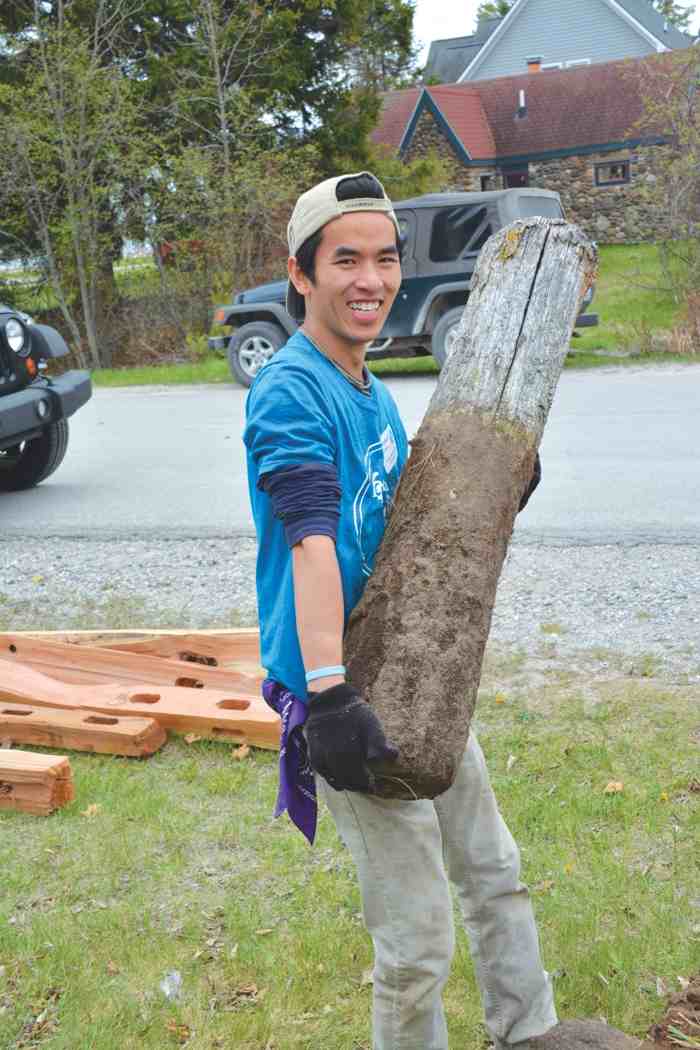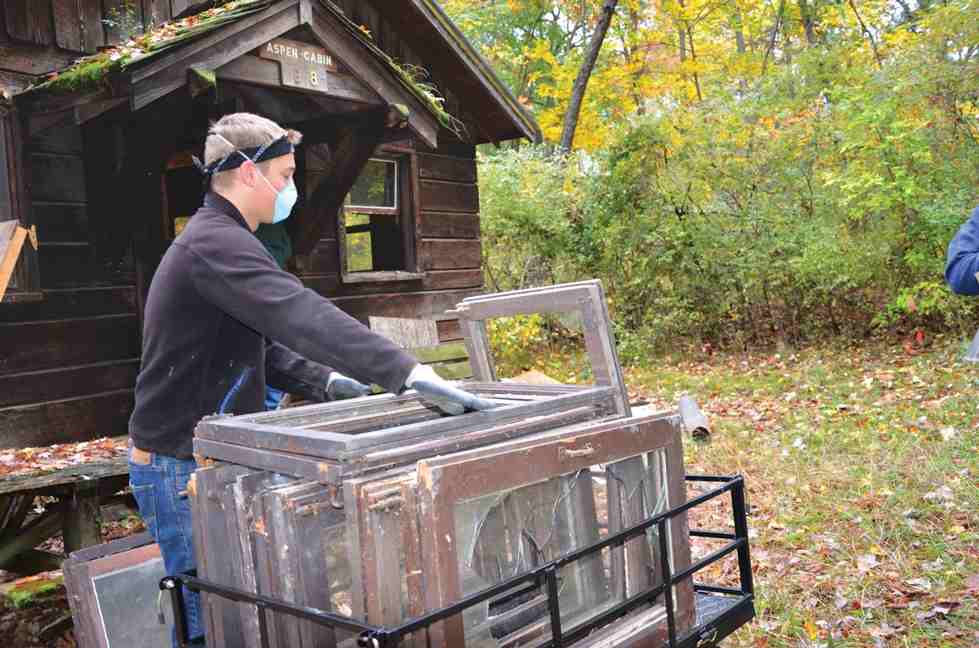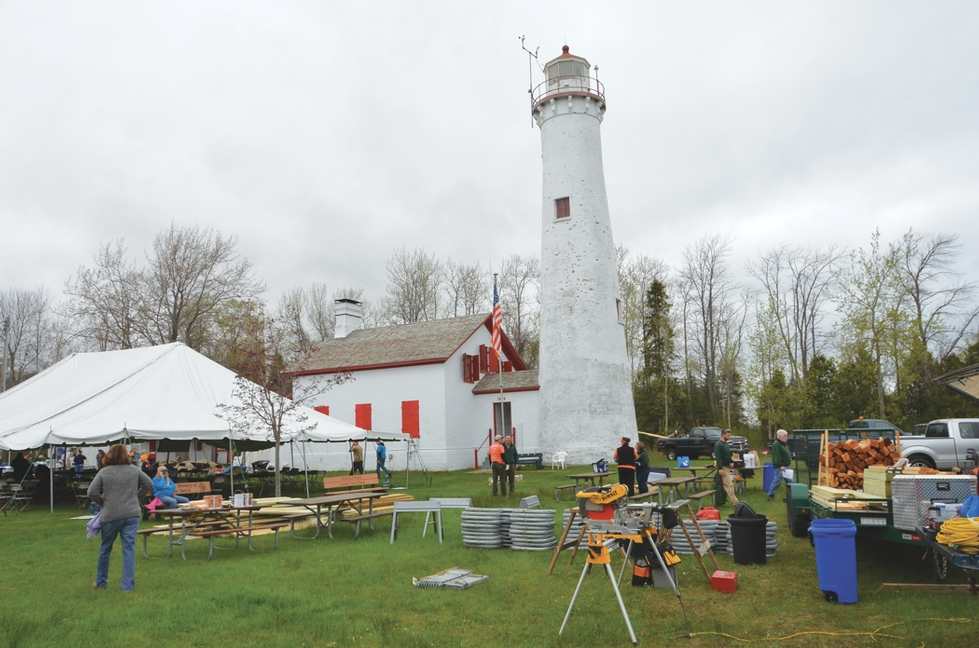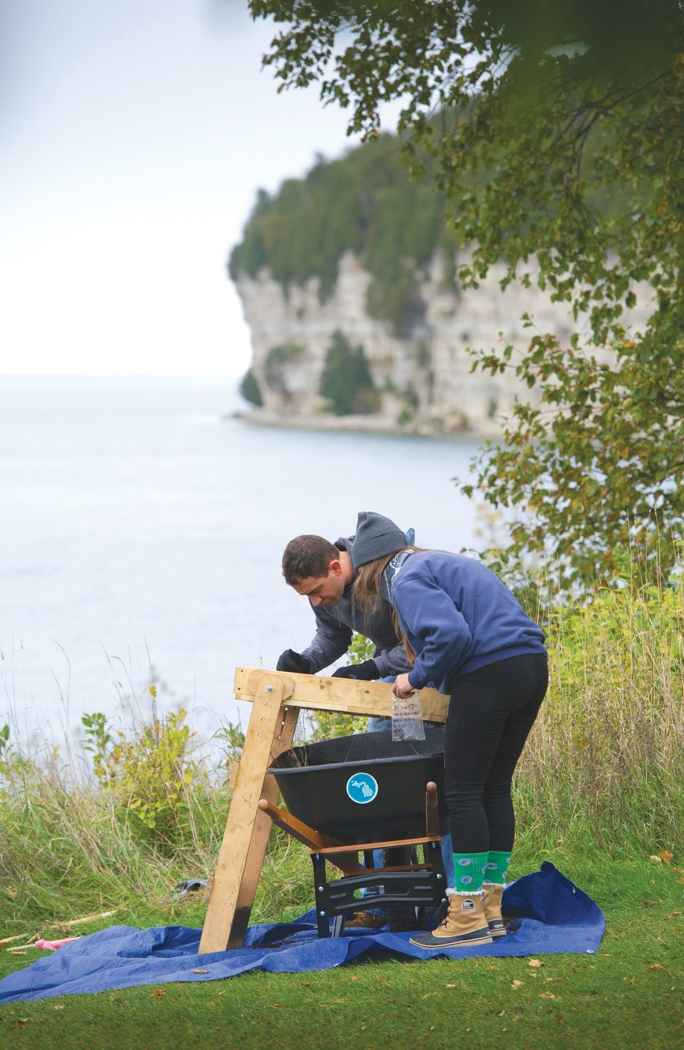Breathing life into historic sites
Grand Valley leads effort to restore state treasures
Four historic Michigan sites, from the Lower Peninsula to the middle of the Upper Peninsula, are now cleaner, brighter and better preserved thanks to the volunteer efforts of hundreds of tourism professionals and Grand Valley students, faculty and staff members.
The four cleanup projects were part of an initiative called Michigan Cares for Tourism (MC4T), which brought together 890 tourism professionals and Grand Valley students, and 165 sponsors. The effort resulted in a savings of $307,000 in labor and supplies for the state.
And, that is just the beginning.
Michigan Cares for Tourism
The MC4T initiative, to help restore and preserve historical sites across the state, began in the Hospitality and Tourism Management Department.
It’s the brainchild of HTM associate professor Patty Janes. “Until now, there has not been a unified, statewide effort to give back to the tourism industry and preserve and invest in our most sacred treasures: our people and our historic attractions,” Janes said.
When Janes came to Grand Valley four years ago, she shared her idea of bringing together state tourism professionals and Grand Valley students to work side-by-side to clean up historic sites. The HTM department was immediately on board.
“We are realizing that hospitality and tourism organizations are starting to look closer at how students are giving back and how they are impacting their communities,” said Paul Stansbie, associate dean in the College of Community and Public Service. “Patty’s idea fit with our model of being an engaged college that emphasizes community engagement and partnerships.”

Sturgeon Point
Historic Mill Lake
Grand Valley chartered MC4T along with the state Department of Natural Resources, Tourism Cares, Pure Michigan, Indian Trails and DRIVEN public relations.
In an effort to get funding, Janes and the MC4T team pitched the idea of the initiative at the Pure Michigan Jump Start Competition in 2013 at the Governor’s Conference on Tourism. The team won first place and used the $5,000 prize money to organize the first cleanup at Historic Mill Lake in the 20,000 acre Waterloo Recreation Area in Chelsea.
Mill Lake, which started in 1936, was the first camp for inner city youth in the area. It closed in 2000.

Mill Lake
“The DNR suggested the site because it doesn’t have the staff or funds needed to restore and rent the cabins or reopen the camp. It’s a beautiful area not being utilized,” said Janes. “The DNR has 240 historic sites that need attention and a $350 million maintenance deficit.”
In October 2013, more than 100 volunteers cleaned out cabins, threw away beds and windows, repaired and painted buildings, cleared brush and removed invasive species.
Janes said because of the large number of workers, volunteers were able to accomplish in one day what would have taken officials six months.
The project also included a FAM or familiarization experience; volunteers arrived the day before to tour places of interest and learn about the destination to grow in their tourism profession. The group visited area sites including the Michigan International Speedway and took a ride in a pace car.
Belle Isle
The Mill Lake cleanup was so successful, Janes again turned to the DNR to suggest a site. This time it was Belle Isle State Park in Detroit; the area received a makeover in May 2014.
The MC4T team sought out sponsors to help with expenses. Indian Trails offered free transportation and several companies, including the Detroit Metro Convention and Visitor’s Bureau and the Chevrolet Detroit Belle Isle Grand Prix, donated meals, snacks, tools and supplies.
More than 450 tourism professionals, including 10 Grand Valley students,worked on nine different projects.
Gov. Rick Snyder and his wife, Sue, showed up to help paint buildings. Volunteers spent the day gutting and painting a welcome center, clearing brush, fixing playground equipment, painting picnic tables and cleaning bathrooms.
Andrea Kenner, a senior majoring in public relations with an HTM minor, helped coordinate the event and register volunteers.
“It was easy to see how much the volunteers care about Belle Isle,” said the Auburn Hills native. “Several volunteers talked about how they used to go to the park as children. It was nostalgic for them.”
The work resulted in $50,000 in saved labor and $30,000 in saved materials and supplies. For the FAM experience, students got a behind-the-scenes tour of the Parade Company, which sponsors the Detroit Thanksgiving Day parade, visited the Ford Piquette Avenue Plant and kicked field goals at Ford Field.

Sturgeon Point Lighthouse
Sturgeon Point Lighthouse
Built in 1869, the Sturgeon Point Lighthouse has helped thousands of vessels navigate Lake Huron.
Located in the Thunder Bay National Marine Sanctuary in Harrisville, the lighthouse is open to the public but doesn’t have enough maintenance staff or volunteers to keep up with needed restoration projects. In May 2015, a group of more than 20 students joined more than 200 tourism professionals to build a split-rail fence, construct bat houses, build and paint picnic tables, clear land for a new parking lot and work on new stone and herb garden landscaping.
Kimberly Beukema, an HTM senior from Zeeland, helped clear brush up to and around the lighthouse, while others painted the main DNR sign and built a fence around it. She said after seven hours of work, she saw a true transformation.
“When we arrived some areas were dirty and run-down,” Beukema said. “We were amazed by the difference we saw at the end of the day. The area and lighthouse looked fresh and clean and more inviting.”
Caylie Peet, a senior from Grand Rapids, helped build a trail to the lighthouse that is handicap accessible and poured concrete to make slabs to display artifacts that were stored inside the lighthouse. “What I did was small, but will have a lasting effect,” Peet said. “Getting the chance to help restore this location was great, but it was incredible to experience the community.”
Community members were so excited about their visit, they arranged for a police escort to guide the buses to the site. The FAM experience had students looking for fossils at Rockport State Park, fishing at a local trout farm and taking a glass-bottom boat excursion at Alpena Shipwreck Tours.
Fayette Historic State Park
Fayette was once a thriving iron ore community in the U.P. in the 1800s. When that industry died, so did the city. The state park is now being reopened as a tourist attraction. In October, 130 tourism professionals, including 25 Grand Valley students, cleared brush around a historic race horse track, painted the superintendent’s house, sanded and primed a fence, and removed brush in the woods to reveal a clear view of the water.
They also sided a building and began the process of plastering the historic hotel.
The Fayette trip was the second MC4T experience for Nicole Prinz, a junior from Fruitport. She also helped with the Sturgeon Point Lighthouse restoration. She said DNR officials estimated the group in Fayette accomplished two years worth of work in one day.
“The wood and siding of buildings were weathered and some walls inside needed to be reinforced,” said Prinz. “It’s amazing how much better the buildings looked after adding a fresh coat of paint and clearing some brush. I was in awe of the beauty of the landscape.”
Students took a cruise along the Pictured Rocks National Lakeshore and visited Palms Book State Park as part of the FAM experience.

Fayette Historic State Park
Looking forward and back
Janes said the benefits and impacts of MC4T are broader and deeper than she could have ever imagined.
The group received a trailer full of supplies to use at each project, donated by the General Agency Company and McCann Detroit. The trailer is loaned to sponsors and also utilized for other efforts like the upcoming Grand River cleanup in April during the National Association of Sports Commissions conference in Grand Rapids and the Pure Michigan Governor’s Conference on Tourism in Lansing.
“Aside from the physical treasure, we’re benefitting business-to-business,” said Janes. “Cross collaboration and networking is critical for the large picture tourism umbrella. Volunteers take groups back to a site, vacation at a site and tell people about the site.”
Stansbie said students are getting the unique experience of working shoulder-to-shoulder with high-level executives. “It’s easier to talk with a CEO when you both have your sleeves rolled up and are covered in paint. It’s a neutral playing field,” said Stansbie. “It becomes very relaxed and students find it is a great way to network and build their careers.”
Janes said moving forward, her team of 20 will plan one trip per year. She said it’s also important to look back.
“We call it the ‘over-the-shoulder moment.’ After working so incredibly hard all day, we stop and look back and see the difference,” she said. “We hope to leave each place significantly better.”
